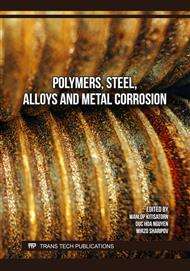p.33
p.41
p.49
p.57
p.65
p.79
p.87
p.97
p.107
Stable Fabrication of Chitosan/Polycaprolactone (CS/PCL) Core-Shell Nanofibers by Electrospinning
Abstract:
Chitosan (CS), with its non-toxic and antibacterial properties, and Poly(ε-caprolactone) (PCL), known for its biodegradability and biocompatibility, are crucial materials in medical applications. This study proposed a solution utilizing electrospinning to manufacture fibers with nanometer-sized core-shell structures from these materials, with CS serving as the fiber core and PCL forming the shell. The influence of manufacturing technology parameters on fiber size and morphology was thoroughly researched and investigated. The solvent system used, Chloroform/Dimethylformamide (DMF), ensured complete solubility, viscosity control, conductivity, and proper solvent evaporation. Transmission Electron Microscopy (TEM) and Scanning Electron Microscopy (SEM) results clearly demonstrated the morphology and internal structure of the nanofibers. The water contact angle (WCA) measurements of the fiber membrane showed almost no significant change over time, indicating strong hydrophobicity of the nanofibers. Additionally, the FTIR spectrum revealed distinct core-shell layers without any blending between them, while DSC analysis showed the thermal properties of fiber membranes. In summary, the electrospinning of nanofibers proved to be stable, producing thin fibers with an average diameter of approximately 400 nm. These findings are expected to significantly enhance the applicability of CS/PCL nanofibers across various fields, including healthcare and smart agriculture.
Info:
Periodical:
Pages:
107-114
Citation:
Online since:
December 2024
Authors:
Keywords:
Price:
Сopyright:
© 2024 Trans Tech Publications Ltd. All Rights Reserved
Share:
Citation:



